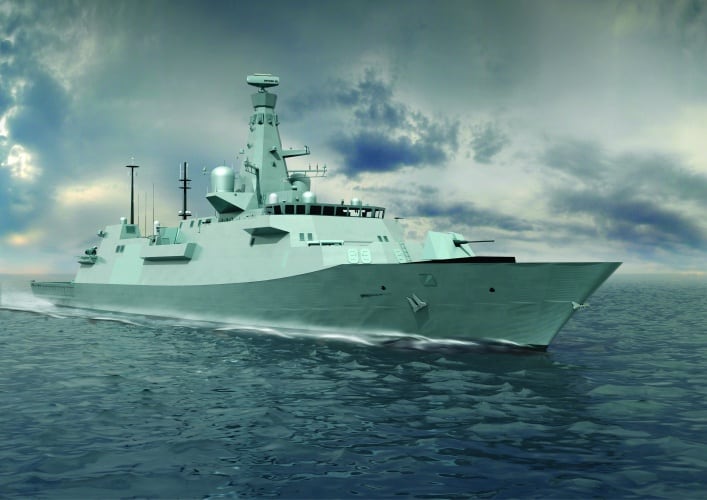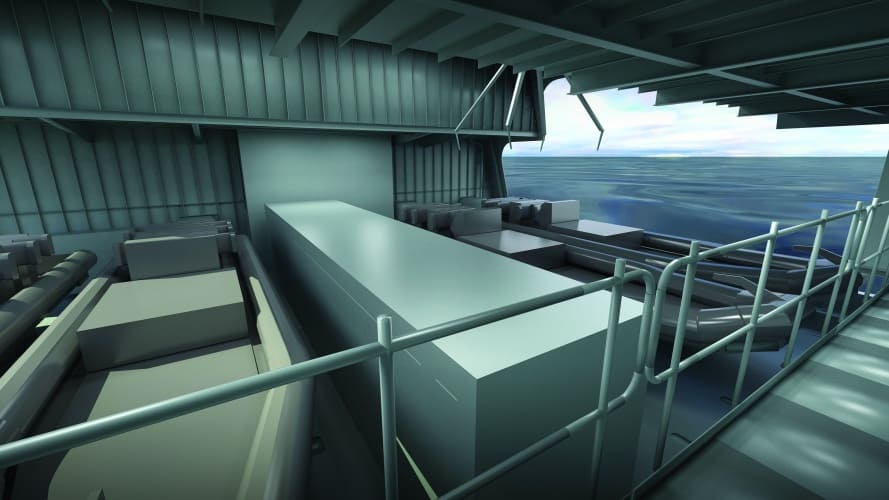
Royal Navy frigates are designed to fight wars but more normally fulfil peacetime roles that involve policing the seas and helping with the provision of humanitarian relief.
A notable example of the frigate’s utility can be found in HMS Argyll, the oldest of the Royal Navy’s Type 23 frigates.
Commissioned in 1991, Argyll notched up successes in October 2014 when her crew helped in a four-day clean-up of Bermuda following Hurricane Gonzalo, an act followed swiftly by the seizure of cocaine valued at £10m from a yacht in the Caribbean.
Before landing back in Plymouth on 18 December, Argyll and her crew thwarted more drug smugglers during a night-time operation that saw the ship hit full throttle to make up 70 nautical miles in pursuit of a small, highly manoeuvrable boat carrying £36m of cocaine.
”Type 23 [frigates] do fantastic work all around the world in a wide range of roles, but fundamentally they were designed as Cold War submarine hunters and over their lifetime their role has changed significantlyGeoff Searle, BAE Systems
The Type 23 is assisted in her quest by the multiple systems and personnel embarked upon her to fulfil her remit, including Lynx helicopters and crew, detachments of Royal Marines, and small patrol boats that together help – in these particular instances – to prevent profit from the sale of controlled substances.
Furthermore, a new addition to the Royal Navy’s reconnaissance team recently saw Type 23 HMS Richmond deploy a ScanEagle unmanned aircraft to help in the seizure of heroin in the Indian Ocean.
One facet that links the achievements of Argyll and Richmond is the demonstration of a frigate’s requirement to work alone or as part of a larger group and the Type 23 replacement, the Type 26, will be no different in that respect.
Geoff Searle, Type 26 programme director at BAE Systems explained that while the tasks required of the Type 26 won’t change, her ability to so will be greatly enhanced, a point of concurrence with Rear Admiral Alex Burton, RN – Type 26 Programme.
“The T26 GCS [Global Combat Ship] design is inherently flexible, allowing greater choice in operational tasking through the incorporation of modular systems,” said Burton. “These include the flexible strike silo – able to host anti-submarine, anti-ship and, if required, land attack strike missiles – and the modular mission bay, as well as increased accommodation to support additional mission teams from specialist ASW teams to communications and mine counter-measure specialists.”
Searle added: “If you look at the Type 23s, they do fantastic work all around the world in a wide range of roles, but fundamentally they were designed as Cold War submarine hunters and over their lifetime their role has changed significantly… they have been used in a wide variety of different roles and military tasks that they originally weren’t designed for.”
The Type 26s will still maintain the role of specialist anti-submarine warfare (ASW) frigate to provide anti-submarine protection to Carrier Task Groups and other Task Groups and key ASW features will include bow sonar, an ASW Merlin helicopter equipped with its own sonars and torpedoes, and the Thales Sonar 2087 system aft of the ship.
“Since its introduction into service with the Royal Navy in 2005, Sonar 2087 has been the mainstay of the Royal Navy’s Surface Ship ASW capability on Type 23 frigates,” said Burton. “It therefore represents an optimal choice for the Type 26 due to its proven high levels of both active and passive performance, the low risk of integrating it into Type 26 and a well-defined product development roadmap, making it viable for the Type 26’s role for the foreseeable future.”
Add multi-helicopter capability – the new ship will be able to embark a Chinook – plus the new mission bay and the Type 26 presents the Royal Navy with a multi-role, multi-mission frigate that will serve into the 2060s and be adaptable enough to react to threats and challenges that emerge in that timespan. “I think [a] step change with the 26 is the dedicated facilities to support that wide range of future payloads, whether it is unmanned aerial vehicles (UAVs), unmanned underwater vehicles (UUVs), Offboard Mine Countermeasure systems, or large boats for maritime security – so it can take up to 12m ribs rather than the standard PAC 24s or PAC 28s – with the facilities to properly handle it, [then] properly maintain and service those different payloads,” said Searle. “As an example, when they embarked ScanEagle on Argyll, there were months of work to prepare to embark it, then safely launch and recover it. A Type 26 would inherently have the ability to embark unmanned vehicles with effectively 24 hours’ notice to re-role.”
a mission load [including containerised cargo including field hospitals, modular accommodation, or disaster-relief stores] can be flown out to wherever the ship is, embarked within 24 hours and then be off and undertaking that taskRear Admiral Alex Burton
Burton added that a ‘tailored-mission’ approach to operations would allow both equipment and crew to be reconfigured to meet rapidly changing operational requirements.
“The idea is that a mission load [including containerised cargo including field hospitals, modular accommodation, or disaster-relief stores] can be flown out to wherever the ship is, embarked within 24 hours and then be off and undertaking that task, and that is a capability the 23s just don’t have because they were never designed to do it,” said Searle.
In August 2015 BAE Systems announced a major milestone in the Type 26 programme with the award of seven manufacturing contracts for the first three ships, including Babcock for the ship’s air weapons handling system, GE Power Conversion for the electric propulsion motor and drive system, plus testing facility, and Rolls-Royce for the supply of MT30 gas turbine (GT) packages.
“The design for the Type 26 GCS is a CODLOG [Combined Diesel Electric or Gas] Propulsion System providing electric motor drive for cruise speed – and ASW stealth – and utilising the gas turbine for sprint,” said Burton.
Richard Partridge, chief of naval systems at Rolls-Royce, added that although GT/hybrid arrangements will normally conduct low-speed/transit and ASW operations on the electric drive and high-speed operation on the ‘boost’ gas turbine, the GT can also support operations at ship speeds below normal electric drive/gas turbine threshold speed, when required by the operational scenario.

Numerous systems on board the Type 26 have been designed to reduce the acoustic signature of the ship, whose electric drive system – powered by the diesel generating sets from Rolls-Royce Power Systems – provide the ultra-low-noise machinery state required to successfully conduct ASW operations.
“That said, the MT30 GT is housed in an acoustic enclosure designed to ensure low levels of airborne noise in the machinery space even at high ship speed/GT operation, which contributes to providing an acceptable ship-noise signature across every operating mode, and, of course, provides acceptable levels of crew habitability,” Partridge said.
While designed to give the Type 26 its sprinting legs, the MT30 also provides the MoD with value for money as it is designed to maintain its rating throughout the life of the ship, regardless of the weight she might gain following refits. This, said Partridge, has a lot to do with the MT30s evolution from the large-core Trent 800 aero engine.
“The MT30 has been conservatively rated at a nominal 36MW, with up to 40MW available on a project-by-project basis as required, which even at the enhanced rating still ensures generous thermal margins and allows a unique rating philosophy with retention of the rated engine power throughout engine life/in-service, despite the inevitable wear and tear on engine seals
and so on through-life,” he said.
It looks very likely that the MoD will order 13 Type 26 Frigates for the Royal Navy and talk has turned to exporting the platform.
“We’re at the early stages of responding to the procurement process of Canada and Germany for future surface combatants,” said Searle. “It’s no secret that there’s interest from potentially Australia and its Sea 5000 future surface combatant.”




Nanogenerator consumes CO2 to generate electricity
Whoopee, they've solved how to keep a light on but not a lot else.